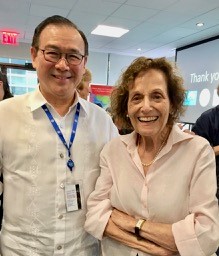A blog by SI United Nations (UN) Representative, New York Barbara Rochman
INHERENT DIGNITY: An Advocacy Guidebook to preventing trafficking for the purpose of sexual exploitation and realizing the human rights of women and girls throughout their lives was launched at the UN Church Center in New York by Mercy International: Mercy Global Action at the UN, on 25 July, 2018.
This is well-researched and informative Guidebook that highlights the human rights approach to fighting against human trafficking for sexual exploitation. Designed in a glossy magazine style, it is filled with attractive paintings and photographs. Interspersed throughout are Text Boxes providing additional resources on human trafficking, publications by individual experts or UN agencies, and information on applicable international conventions, compacts and protocols.
Why is Inherent Dignity in the title? As stated in the Foreword of the Guidebook, it comes from the Universal Declaration of Human Rights, the 70th Anniversary of which we celebrate this year. The Declaration recognised that “the inherent dignity of all members of the human family is the foundation of freedom, justice and peace in the world.”
In the Guidebook we learn the true story of ‘Cathy’ using her own words to tell how she grew up, was tricked into being trafficked at 16, was sexually exploited, and lost her freedom.

Photo: H.E. Ambassador Mr. Teodor L. Locsin, Jr., Philippine Permanent Representative to the United Nations with Barbara T. Rochman SI UN Rep.
Soroptimist InternationaI’s, Where We Stand Statement on Human Trafficking, “… recognizes that trafficking in persons is a heinous violation of fundamental human rights and must be strongly combatted. The consequences of human trafficking have a spillover effect that touches every element of a society.”
The Guidebook can be a significant tool for Soroptimist International members, clubs, regions and international leaders to identify how human rights violations can lead to human trafficking; to better understand why girls and women become trafficked; and to become more knowledgeable about using international human rights laws to fight trafficking, noting the indivisible and interrelated qualities of all human rights.
Part 1: of the Guidebook is an introduction stating at the outset that Trafficking for the Purpose of Sexual Exploitation Violates the Human Rights of Women and Girls. It provides helpful definitions and shows that this is a crime under International law. A special section deals with Trafficking in Conflict Zones. Another section talks about using human rights law in advocacy.
Part 2: highlights the necessity of Listening to Survivors and presents
Cathy’s experiences. As the child of a prostitute, Cathy lived with her paternal grandmother. She only met her mother once. When Cathy was 13 her mother died from a beating and Cathy attended her funeral. She said that, “If she could turn back time she would love to have her mother, even for one month, so that she could feel her love.”
Part 3: The Right of the Child to Special Protection, traces how Cathy’s human rights were violated while she was young and how these violations made her vulnerable to sex trafficking. Cathy’s story is in many ways typical of the stories of trafficked girls and women who have often suffered one or more forms of abuse while young, whether “physical, sexual, emotional or mental.”
This section also outlines the Convention on the Rights of the Child which sets forth rights specific to children, recognising, that children should develop their full potential and be free from hunger and want, neglect and abuse.” States have an obligation to protect children from all forms of sexual exploitation and abuse, and must take action to prevent abduction, sale or trafficking of children.
Education is an essential human right of children. It is clear that the failure to receive an adequate education is another prime reason that many girls and women end up trafficked. Further sections under Part Three deal with the Right to an Adequate Standard of Living, The Right to be Free from Violence and the Right to be Free from Discrimination.
Part 4: of the Guidebook details additional human rights violations occurring during Cathy’s time as a trafficking victim. She had to turn over all she earned when she was prostituted to her two women managers. She had no money because she was indebted to them for lodging, food, clothing and makeup. She could not escape because there were always “watchers.” In this situation Cathy had no Rights to Freedom of Movement, Liberty and Security: no Free Choice of Employment; and she could not exercise her Right to Freedom from Slavery and Forced Labor.
Part 5: deals with Governments’ Obligations to Prevent Trafficking, and the various applicable human rights protocols and instruments to prevent trafficking in persons are described.
Part 6: What Organizations and Individuals Can Do, urges individuals and organizations to empower survivors by facilitating their participation and actively including them in the design, development, and rollout of programs. It also talks about how to prepare advocates for engaging with Governments and how to file complaints about human rights violations.
In the Guidebook’s Conclusion, the authors reiterate that, “… for the most part marginalization, discrimination, and gendered violence are common preconditions for vulnerability to trafficking. Therefore, trafficking actually occurs as a result of a process of systemic victimization over the life course.”
The Guidebook very successfully meets its goal to assist advocates and others to use the human rights approach as they collaborate with
NGOs, governments, groups and individuals to prevent trafficking for the purposes of sexual exploitation, and to help trafficking survivors.
Primary Author, Rose Bryant Smith Secondary Author Reed, Ph.D., RSM Project Coordinator, Colleen Cloonan
You can download a free pdf of the Guidebook, or request a hard copy paying only postage, at http://www.mercyworld.org

